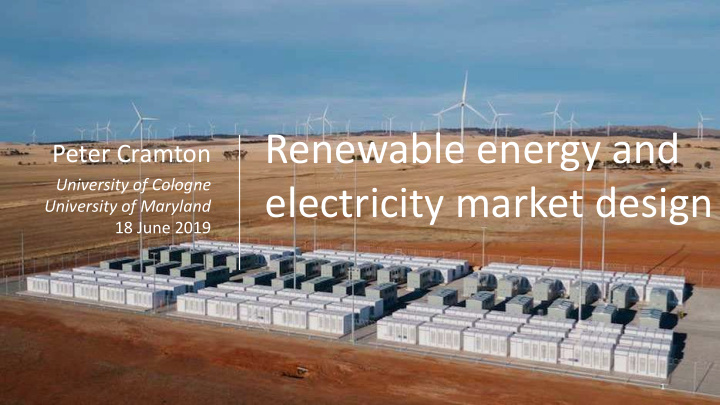



Renewable energy and Peter Cramton University of Cologne electricity market design University of Maryland 18 June 2019 1
Goal of electricity markets: Reliable electricity at least cost Short-run Long-run efficiency efficiency Least-cost Right quantity operation of and mix of existing resources resources
• Must balance supply and demand at every instant • Physical constraints of network and resources • Shocks in supply Challenges of – Transmission line or generator electricity markets outage – Intermittent resources: wind and solar • Absence of demand response • Climate policy 3
• Get the spot market right – Day ahead • Scheduling and unit commitment A successful market – Real time design • Bid-based security constrained economic dispatch • Forward trade to manage risk and support long-run investment 4
Day-ahead market Objective: maximize Unit commitment and Three-part offers from social welfare Virtual offers and bids scheduling fossil resources s.t. transmission and resource constraints Energy and Arbitrage day- Co-optimized ancillary services Startup cost ahead and real- energy and each hour of day time markets reserves Prices for energy Competitive and reserves; Minimum-energy equilibrium with financially cost locational binding marginal prices (marginal value of energy at each Energy offer location) curve
Day-ahead market Handling non- • If total cost of unit not covered by energy & reserve convexities, such as revenue, then unit gets make-whole payment for shortfall • Make-whole payments small in practice startup and minimum • LMPs are approximate supporting prices energy costs • Allows small generators to optimally schedule Procompetitive • Allows small participants to hedge real-time risk
• Generator submits operating plan for each Operating resource – Online/offline, constraints plan and • Until 60 minutes before operating hour, plan can be adjusted adjustment • System operator may commit additional period resources for reliability, but these have a high offer floor ($1500/MWh)
Ancillary services Address supply/demand uncertainty: • Regulation: online, responds in second • Reg up, Reg down to maintain frequency of 60 Hz • Responsive reserve: online, 10min response • Non-spinning reserve: offline, 30min response Need for reserves depends on market; products and quantities reviewed periodically
9 Source: Potomac Economics
10 Source: Potomac Economics
Real-time market Security constrained economic dispatch Determines optimal dispatch and prices every five minutes Financially and physically binding Allows efficient settlement from forward positions
Day-ahead and real-time markets highly liquid 12
13
14
• Reserves have value in avoiding load shedding • Marginal value of reserves depends on – Value of Lost Load, e.g. $9000/MWh Shortage pricing – Probability of Lost Load, e.g. 1 when start shedding load • Load’s implicit preference for reliability given by operating reserve demand curve 15
Operating reserve demand curve 16
17 Source: Potomac Economics
• Forward contracts are essential to manage risk – California energy crisis 2000-2001 – Forward provides hedge for load Forward – Generator + fuel contract provides physical hedge for supply contracts • Shortage pricing motivates forward contracts • Forward contracting improves bidding incentives
19 Source: Potomac Economics
20 Source: Potomac Economics
21 Source: Potomac Economics
Investment 22
23 Source: Potomac Economics
24 Source: Potomac Economics
25 Source: Potomac Economics
26 Source: Potomac Economics
• ERCOT is “energy only”; many others have a capacity market (PJM, ISO-NE, …) • Good capacity markets rely on shortage pricing, just like energy-only market • Buy enough in advance – Conducted several years in advance, so new entry can compete before costs are sunk Capacity market – Product is ability to deliver energy during shortage – Strong performance obligation • Financial obligation to provide energy during shortage • Provides hedge to load from shortage prices – Coordinated investment to ensure adequate resources 27
28 Source: Potomac Economics
Transformation to renewables 29
Source: IRENA
• Last year 60% of new capacity in US is wind and solar • Coal hasn’t been built in years • Intermittent supply, zero marginal cost, no inertia – More uncertainty, worse price formation, faster response needed – Also best sites not where load is; transmission issues • Today’s design easily handles moderate share of wind 33
34 Source: Potomac Economics
35 Source: Potomac Economics
36 Source: Potomac Economics
• But what if >80% renewable • Core design still works well • More flexibility needed – Demand response (smart homes) Solution looking – Battery storage forward Need to encourage technology-neutral solutions! 37
Greater need for flexibility ⇒ efficient price signals increasingly important • Nodal pricing – Price reflects scarcity at time and location – Pretending no congestion does not work • German redispatch cost of €1.5 billion in 2018 • Wrong price signal; poor location incentives • Shortage pricing – Motivate those to provide flexibility 38
• Each customer has smart meter • System operator estimates demand of customer • System operator buys forward estimated demand Enable demand • Real-time deviations settled response with good at real-time price default retail contract • Customer can opt out of default 39
• Policy built on myriad of changing subsidies and emission restrictions makes planning Incoherent difficult • Uncertainty harms investment and unstable • Policy based on carbon price would greatly climate policy reduce uncertainty • Carbon price is a critical input in investment and retirement decision
Carbon dividend (pending US legislation) • Carbon price, increasing each year until goal met • Revenue rebated back to citizens • Replaces inefficient regulations • Carbon border adjustments for reciprocity Widely supported (4-1 overall) Good basis for climate club e.g. US, Europe, and China 41
• Electricity good example of the power of market design – Highly efficient spot market – Supporting extensive forward contracting – Competitive retail market to foster Conclusion demand response • Good governance remains important to make sure market design continues to improve and addresses new challenges like the transition to renewables 42
Recommend
More recommend